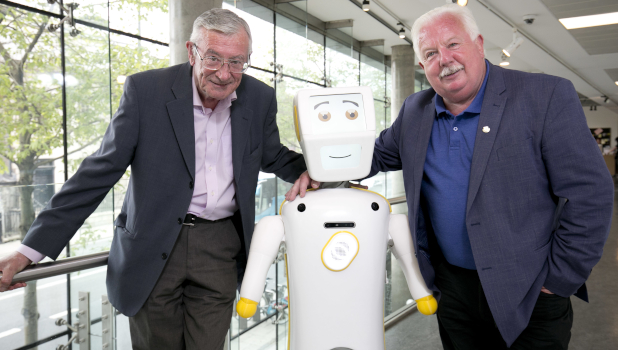
TCD robotics engineers unveil Stevie II, Ireland’s first socially assistive AI robot
Stevie II, Irelands first socially assistive robot, was unveiled by Trinity College robotics engineers from at Science Gallery Dublin last Wednesday.
In 2017, its namesake, Stevie, showed the country that socially assistive robots could be used in care environments to help seniors and the disabled.
With its considerable technological upgrades and advanced artificial intelligence (AI) capabilities, Stevie II can build upon that success.
While Stevie is still currently being piloted, the team expects its first permanent deployment sometime next year.
Commenting on the project, its principal investigator, assistant professor in Trinity’s School of Engineering, Dr Conor McGinn, said: “We found from interviews and focus groups that seniors enjoyed interacting with Stevie. It being so expressive helped to humanise the technology in a way that surpassed our expectations.”
“These insights lead us to believe that a robot like Stevie can have a wide range of high-impact uses, which may involve performing numerous assistive tasks, helping caregivers, and may even provide new interfaces to existing technologies – like video calling, smart sensors, social media – that can be inaccessible to many older adults.”
Now, Stevie has superior expressive capabilities and is more diverse, with wireless connectivity (ie Wi-Fi, Bluetooth), and on-board computers.
To support a more intelligent interaction with its environment, Stevie II has improved mobility, dexterity and advanced sensing technologies, including laser rangefinders, depth cameras and inertial and vision sensors.
To enhance the user experience, nurses, caregivers and older individuals were consulted throughout development. Alone, an Irish organisation which helps older people remain independent and socially connected, was also involved in the process.
Seán Moynihan, CEO of Alone, said: “Often there is an assumption that older people and technology don’t mix, but the response to Stevie from the older people we work with shows that this is simply not the case.
“We hope that innovative solutions like those provided by Stevie and also by ourselves in Alone through our BConnect technology will be utilised to ensure older people across the country can access the best supports available.”
Stevie II has also been put to the test at the Knollwood Retirement Community, Washington DC, operated by US-based Army Distaff Foundation.
Its associate executive director, Matt Reilly, commented on the results of a recent pilot. “The research conducted over the past year with our partners from Trinity College Dublin is very promising and has significant potential for allowing us to incorporate this technology into our care delivery systems across the continuum of aging.
“Whether deployed in independent living, assisted living, or skilled nursing, social assistance robotics platforms such as Stevie, driven by sophisticated AI, become tools that can help our care staff increase their performance and improve care outcomes. We are truly excited to be on the forefront of employing this technology.”
Several more pilots are planned for the coming months, including a European-funded stint at long-term care facilities in Cornwall.
TechCentral Reporters








Subscribers 0
Fans 0
Followers 0
Followers